WASHINGTON — The Grain Foods Foundation (GFF) has asked the 2025 Dietary Guidelines Committee to distinguish between staple and indulgent grain-based foods and develop dietary recommendations that reflect how various population subgroups consume food.
In a letter to Janet M. de Jesus with the Office of Disease Prevention and Health Promotion, GFF executive director Erin Ball expressed concern about the representation of refined, enriched grains in public health messages and the potential adverse effects from them on nutrition security and advocacy.
“While previous Dietary Guidelines for Americans have recommended making half your grains whole (and approximately half enriched and fortified), refined, enriched grains are persistently mischaracterized in research and maligned in dialogue about nutritious foods and healthy dietary patterns,” Ball’s letter said. “The broad category of grain foods is comprised of staple and indulgent grain food options — and these categories are very different in their nutritional value and contributions to daily intake and a healthy eating pattern.”
The letter cites 30 academic studies to back up its requests for the Committee’s consideration in crafting the next dietary guidelines.Staple versus indulgent
The request for clarity between the two terms reiterates that both types of grain foods have an important role and contribution to a healthy diet.
“When studied individually, versus as part of a defined ‘unhealthy eating pattern,’ refined grain foods are not associated with diet-related health conditions,” the letter said. “Most cohort studies show no association between intake of refined grain foods and body mass index and increased risk of cardiovascular disease, stroke, cancer, or all-cause mortality. Additionally, most published data suggest that intake of refined grain foods is not associated with increased risk of type 2 diabetes.”
The letter cited an expert panel’s recommendations that grain foods categorized as indulgent be limited in diet due to calories, added sugar, sodium and saturated fat. The same panel recommended additional classification of refined grain foods beyond “whole” and “refined” when assessing nutrient intake, diet quality and health-related concerns.
“This is the only way in which to make the scientific recommendations underpinning dietary guidance most accurate and constructive,” Ball said in the letter.
Reflect subgroup eating patterns
Addressed in the text of the letter is a warning on the potentially disastrous repercussions for health equity, nutrition security and food access from public maligning of grain-based foods as a whole.
“Because most in the US are enriched and fortified, they serve as an important source of critical nutrients for vulnerable populations, like women of childbearing age, including folate and iron,” Ball said.
Additional points from the section address:
- Removal of barriers to accessing and utilizing foods that are part of cultural foodways.
- Most Americans currently underconsume key nutrients such as fiber, and more than half of all US fiber intake comes from grain foods.
- Populations vulnerable to nutrient inadequacy, such as children and women of childbearing age, must be replete in key nutrients that enriched and fortified staple refined grains include.






